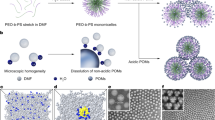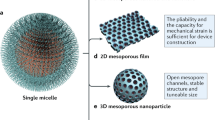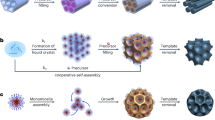Abstract
Surfactant-mediated synthesis strategies are widely used to fabricate ordered mesoporous solids1,2,3,4,5,6 in the form of metal oxides7, metals8, carbon9 and hybrid organosilicas10,11,12,13,14. These materials have amorphous pore walls, which could limit their practical utility. In the case of mesoporous metal oxides, efforts to crystallize the framework structure by thermal15,16 and hydrothermal treatments17 have resulted in crystallization of only a fraction of the pore walls. Here we report the surfactant-mediated synthesis of an ordered benzene–silica hybrid material; this material has an hexagonal array of mesopores with a lattice constant of 52.5 Å, and crystal-like pore walls that exhibit structural periodicity with a spacing of 7.6 Å along the channel direction. The periodic pore surface structure results from alternating hydrophilic and hydrophobic layers, composed of silica and benzene, respectively. We believe that this material is formed as a result of structure-directing interactions between the benzene–silica precursor molecules, and between the precursor molecules and the surfactants. We expect that other organosilicas and organo-metal oxides can be produced in a similar fashion, to yield a range of hierarchically ordered mesoporous solids with molecular-scale pore surface periodicity.
This is a preview of subscription content, access via your institution
Access options
Subscribe to this journal
Receive 51 print issues and online access
$199.00 per year
only $3.90 per issue
Buy this article
- Purchase on Springer Link
- Instant access to full article PDF
Prices may be subject to local taxes which are calculated during checkout




Similar content being viewed by others
References
Yanagisawa, T., Shimizu, T., Kuroda, K. & Kato, C. The preparation of alkyltrimethylammonium-kanemite complexes and their conversion to microporous materials. Bull. Chem. Soc. Jpn 63, 988–992 (1990).
Kresge, C. T., Leonowicz, M. E., Roth, W. J., Vartuli, J. C. & Beck, J. S. Ordered mesoporous molecular sieves synthesized by a liquid-crystal template mechanism. Nature 359, 710–712 (1992).
Beck, J. S. et al. A new family of mesoporous molecular sieves prepared with liquid crystal templates. J. Am. Chem. Soc. 114, 10834–10843 (1992).
Inagaki, S., Fukushima, Y. & Kuroda, K. Synthesis of highly ordered mesoporous materials from a layered polysilicate. J. Chem. Soc. Chem. Commun. 680–682 (1993).
Firouzi, A. et al. Cooperative organization of inorganic-surfactant and biomimetic assemblies. Science 267, 1138–1143 (1995).
Bagshaw, S. A., Prouzet, E. & Pinnavaia, T. J. Templating of mesoporous molecular sieves by nonionic polyethylene oxide surfactants. Science 269, 1242–1244 (1995).
Ying, J. Y., Mehnert, C. P. & Wong, M. S. Synthesis and applications of supramolecular-templated mesoporous materials. Angew. Chem. Int. Edn Engl. 38, 56–77 (1999).
Attard, G. S. et al. Mesoporous platinum films from lyotropic liquid crystalline phases. Science 278, 838–840 (1997).
Joo, S. H. et al. Ordered nanoporous arrays of carbon supporting high dispersions of platinum nanoparticles. Nature 412, 169–172 (2001).
Inagaki, S., Guan, S., Fukushima, Y., Ohsuna, T. & Terasaki, O. Novel mesoporous materials with a uniform distribution of organic groups and inorganic oxide in their framework. J. Am. Chem. Soc. 121, 9611–9614 (1999).
Melda, B. J., Holland, B. T., Blanford, C. F. & Stein, A. Mesoporous sieves with unified hybrid inorganic/organic framework. Chem. Mater. 11, 3302–3308 (1999).
Asefa, T., MacLachlan, M. J., Coombs, N. & Ozin, G. A. Periodic mesoporous organosilicas with organic groups inside the channel walls. Nature 402, 867–871 (1999).
Guan, S., Inagaki, S., Ohsuna, T. & Terasaki, O. Cubic hybrid organic-inorganic mesoporous crystal with a decaoctahedral shape. J. Am. Chem. Soc. 122, 5660–5661 (2000).
Stein, A., Melde, B. J. & Schroden, R. C. Hybrid inorganic-organic mesoporous silicates—Nanoscopic reactors coming of age. Adv. Mater. 12, 1403–1419 (2000).
Yang, P., Zhao, D., Margolese, D. I., Chmelka, B. F. & Stucky, G. D. Generalized syntheses of large-pore mesoporous metal oxides with semicrystalline frameworks. Nature 396, 152–155 (1998).
Lee, B., Lu, D., Kondo, J. N. & Domen, K. Single crystal particles of a mesoporous mixed transition metal oxide with a wormhole structure. Chem. Commun. 2118–2119 (2001).
Liu, Y., Zhang, W. & Pinnavaia, T. J. Steam-stable MSU-S aluminosilicate mesostructures assembled from zeolite ZSM-5 and zeolite beta seeds. Angew. Chem. Int. Edn Engl. 40, 1255–1258 (2001).
Kruk, M. & Jaroniec, M. Gas adsorption characterization of ordered organic-inorganic nanocomposite materials. Chem. Mater. 13, 3169–3183 (2001).
Cerveau, G., Corriu, R. J., Dabiens, B. & Bideau, J. L. Synthesis of stable organo(bis-silanetriols): X-ray powder structure of 1,4-bis(trihydroxysilyl)benzene. Angew. Chem. Int. Edn Engl. 39, 4533–4537 (2000).
Loy, D. A. & Shea, K. J. Bridged polysilsesquioxanes—Highly porous hybrid organic-inorganic materials. Chem. Rev. 95, 1431–1442 (1995).
Corriu, R. J. P. Ceramics and nanostructures from molecular precursors. Angew. Chem. Int. Edn Engl. 39, 1376–1398 (2000).
Harmer, M. A., Farneth, W. E. & Sun, Q. Towards the sulfuric acid of solids. Adv. Mater. 10, 1255–1257 (1998).
Acknowledgements
We thank S. Yamamoto for help in computer simulation of structural models, and S. Hyde for critical reading of the manuscript. O.T. was supported by CREST, Japan Science and Technology Corporation.
Author information
Authors and Affiliations
Corresponding author
Ethics declarations
Competing interests
The authors declare no competing financial interests.
Rights and permissions
About this article
Cite this article
Inagaki, S., Guan, S., Ohsuna, T. et al. An ordered mesoporous organosilica hybrid material with a crystal-like wall structure. Nature 416, 304–307 (2002). https://doi.org/10.1038/416304a
Received:
Accepted:
Issue Date:
DOI: https://doi.org/10.1038/416304a
This article is cited by
-
Mesoporous nanoperforators as membranolytic agents via nano- and molecular-scale multi-patterning
Nature Communications (2024)
-
Size-tuning of hollow periodic mesoporous organosilica nanoparticles (HPMO-NPs) using a dual templating strategy
Journal of Sol-Gel Science and Technology (2023)
-
Hollow Mesoporous Silica Nanoparticles for Dual Chemo-starvation Therapy of Hepatocellular Carcinoma
Pharmaceutical Research (2023)
-
POM@PMO plastic electrode for phosphate electrochemical detection: a further improvement of the detection limit
Microchimica Acta (2023)
-
Gel structure and water desalination properties of divinylpyrazine-bridged polysilsesquioxanes
Journal of Sol-Gel Science and Technology (2023)
Comments
By submitting a comment you agree to abide by our Terms and Community Guidelines. If you find something abusive or that does not comply with our terms or guidelines please flag it as inappropriate.



